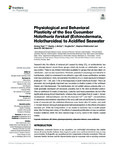Physiological and Behavioral Plasticity of the Sea Cucumber Holothuria forskali (Echinodermata, Holothuroidea) to Acidified Seawater
| dc.contributor.author | Yuan, X | |
| dc.contributor.author | McCoy, SJ | |
| dc.contributor.author | Du, Y | |
| dc.contributor.author | Widdicombe, S | |
| dc.contributor.author | Hall-Spencer, Jason | |
| dc.date.accessioned | 2018-12-10T12:32:00Z | |
| dc.date.issued | 2018-09-25 | |
| dc.identifier.issn | 1664-042X | |
| dc.identifier.issn | 1664-042X | |
| dc.identifier.other | ARTN 1339 | |
| dc.identifier.uri | http://hdl.handle.net/10026.1/13007 | |
| dc.description.abstract |
Research into the effects of reduced pH caused by rising CO2 on echinoderms has been strongly biased toward those groups which rely heavily on calcification, such as sea urchins. There is very limited information available for groups that are less reliant on calcification, such as sea cucumbers. Moreover, plasticity in physiology and behavior in holothurians, which is considered to be critical to cope with ocean acidification, remains even less understood. Here, we examined the effects of a 22-week exposure to three pH levels (pH 7.97, 7.88, and 7.79) on the responses of adult Holothuria forskali. This is an abundant and ecologically important sea cucumber in shallow waters of the northeast Atlantic and Mediterranean. The holothurians did not exhibit serious acidosis after a 4-week gradually decreased pH exposure, possibly due to the slow acclimation period. After an additional 18 weeks of exposure, coelomic acid-base parameters did not differ significantly among the pH treatments, whereas they were higher than in week 4. Gonad development, defense behavior, and the structure and Ca2+ and Mg2+ concentrations of calcareous endoskeleton deposited in the body wall were all unaffected by decreased levels of seawater pH. No statistical differences were found after 22 weeks, and adult H. forskali showed strong physiological and behavioral plasticity to the effects of lowered seawater pH. While the interpretation of our results is restricted due to small sample sizes, this first long-term study of the effects of seawater acidification on sea cucumbers revealed resilience within the wide natural range of pCO2 found in NE Atlantic coastal waters. | |
| dc.format.extent | 1339- | |
| dc.format.medium | Electronic-eCollection | |
| dc.language | eng | |
| dc.language.iso | en | |
| dc.publisher | Frontiers Media | |
| dc.subject | holothurians | |
| dc.subject | NE Atlantic | |
| dc.subject | physiological plasticity | |
| dc.subject | antipredator behavior | |
| dc.subject | ocean acidification | |
| dc.title | Physiological and Behavioral Plasticity of the Sea Cucumber Holothuria forskali (Echinodermata, Holothuroidea) to Acidified Seawater | |
| dc.type | journal-article | |
| dc.type | Journal Article | |
| plymouth.author-url | http://gateway.webofknowledge.com/gateway/Gateway.cgi?GWVersion=2&SrcApp=PARTNER_APP&SrcAuth=LinksAMR&KeyUT=WOS:000445633800002&DestLinkType=FullRecord&DestApp=ALL_WOS&UsrCustomerID=11bb513d99f797142bcfeffcc58ea008 | |
| plymouth.issue | SEP | |
| plymouth.volume | 9 | |
| plymouth.publication-status | Published online | |
| plymouth.journal | Frontiers in Physiology | |
| dc.identifier.doi | 10.3389/fphys.2018.01339 | |
| plymouth.organisational-group | /Plymouth | |
| plymouth.organisational-group | /Plymouth/Faculty of Science and Engineering | |
| plymouth.organisational-group | /Plymouth/Faculty of Science and Engineering/School of Biological and Marine Sciences | |
| plymouth.organisational-group | /Plymouth/PRIMaRE Publications | |
| plymouth.organisational-group | /Plymouth/REF 2021 Researchers by UoA | |
| plymouth.organisational-group | /Plymouth/REF 2021 Researchers by UoA/UoA07 Earth Systems and Environmental Sciences | |
| plymouth.organisational-group | /Plymouth/Research Groups | |
| plymouth.organisational-group | /Plymouth/Research Groups/Marine Institute | |
| plymouth.organisational-group | /Plymouth/Users by role | |
| plymouth.organisational-group | /Plymouth/Users by role/Academics | |
| dc.publisher.place | Switzerland | |
| dcterms.dateAccepted | 2018-09-05 | |
| dc.rights.embargodate | 2018-12-18 | |
| dc.identifier.eissn | 1664-042X | |
| dc.rights.embargoperiod | Not known | |
| rioxxterms.versionofrecord | 10.3389/fphys.2018.01339 | |
| rioxxterms.licenseref.uri | http://www.rioxx.net/licenses/all-rights-reserved | |
| rioxxterms.type | Journal Article/Review |


